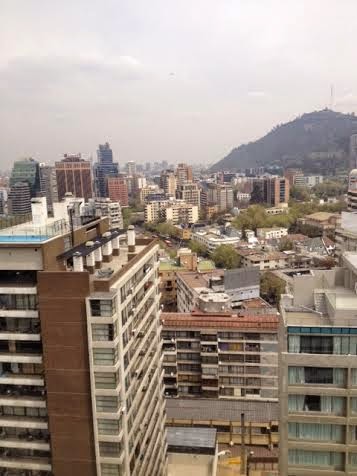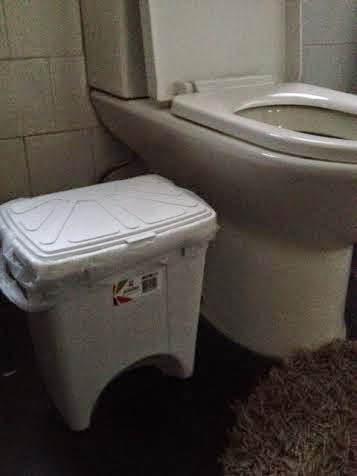Even my Spanish I students will know the title of this post. Dieciocho means 18 in Spanish (and diecinueve means 19). September 18th and 19th mark the fiestas patrias (independence holidays) in Chile.
September 18th commemorates the first meeting of Chile's governing body (1810). This day put into process Chile's independence.
September 19th is the Day of the Armies' Glories.
All Chileans technically have the 18th and 19th off of work, although many business professionals decide to take the whole week off. This year, since September 18th and 19th fell on a Thursday and Friday, the celebrations made for a nice long weekend for most people.
Many Chileans celebrate the fiestas patrias in two ways: at family barbeques and neighborhood fondas. Fondas are regional festivals. I'll explain them in more detail through the photos, but in general, they're fairs/parties held in parks, they represent a comuna (which is like a large neighborhood or borrough - Brooklyn would be a comuna of New York City, for example), they cost about $7 USD for entry, and inside there are food vendors, artists, games, rides, and shows.
We did a little of both the barbeque and the fonda.
Google.cl (.cl is Chile's version of .com) provided this Google doodle for the 18th. The second "o" in Google is a platter of empanadas accompanied by a mote con huesillos.
We hung a flag outside our window. This is the view down to the street from our bedroom.
On the 18th, we went to the fonda for our comuna, which is called Providencia. Providencia is a quiet but hip neighborhood that a lot of young professionals choose to live in. This picture was taken at a bus stop, which had a large poster of different dieciocho events throughout our section of the city.
Matt's pointing to the activity we chose: a fonda in Parque Inés de Suárez, a park about a mile from our house.
Our fonda cost 4.000 pesos (about $7 USD) for entry. We were immediately greeted by a chocolate vendor. This booth had rows upon rows of chocolate kebabs. There were chocolate covered strawberries (which made me think of my mom - those are her favorites), chocolate covered marshmallows, chocolate covered pineapple, chocolate covered kiwi... all kinds of lovely chocolate!
My favorite part of any festival is always the craft vendors. They're called artesanos here (like the word "artisans" in English). Many of the artesanos are indigenous people. I loved looking at the crafts, the paintings, the woven clothes, and the toys. I would post pictures of what I bought, but they're all future Christmas gifts, so for now I can't post them!
I also love fair food. Who doesn't? I put myself on a strict diet, so the only thing I had at the fonda was popcorn, but boy oh boy did everything smell incredible. Kebabs were hugely popular. These kebabs are meat (beef or pork) with onions, although there were vegetarian options. When they're ordered, they're taken off the grill and a large hunk of bread is put on top.
Kebab grillers keeping careful watch.
The big drink (or cocktail, rather) here is the terremoto. Terremoto means earthquake (so Chilean). To make it, you put a dollop of pineapple icream in a cup, pour grenadine syrup on it, then fill it to the brim with pipeño. Pipeño is "young wine," which is a bit sweeter than regular wine, as well as lighter in color and stronger in alcohol content.
They're pretty drinks. I don't drink, but I was certainly present for a lot of terremoto consumption.
On the grill here are empanadas and choripan. Empanadas are popular in lots of Latin American countries. Essentially, they're bread pockets filled with meat (or for vegetarians, cheese and veggies). The most popular empanada in Chile is the pino empanada, which is an empanada filled with beef, onion, and olives. Matt was more interested in the choripan than the empanadas, however. Choripan is a chorizo (type of sausage, pretty well known in the US) wrapped in pan (which is the Spanish word for bread). It's somewhat comparable to a hotdog in its construction, but Matt will tell you that they don't compare in terms of taste and experience (and that's coming from a man who loves hotdogs).
Matt loading up his choripan with mayo (Chile almost always has house-made mayo), mustard (which is sweet in Chile), and ketchup (which is also quite sweet).
The carabineros (police) were there keeping things in order. In every other Latin American country, the police are called policía, but in Chile, they're called carabineros. I don't know why that is. The somewhat derrogatory slang word for police in Chile is pacos.
Here's Matt being swept away on the dance floor.
In front of families eating.
There were also artisanal cheeses to be found. Cheese kebabs were popular and cheap.
There were plenty of sweets, including alfajores and manjar, which I've mentioned before.
There were plants for sale, too.
There were circus-style games for kids.
The weather was beautiful.
There was a children's band performing called Cantando aprendo a hablar (which means "Singing, I learn to talk"). They were a cutesy band with a bunny rabbit on lead guitar. As goofy and cutesy as a lot of their lyrics were, they actually rocked pretty hard. Matt and I got a kick out of their bass and guitar riffs. They sounded a bit like Les Claypool / Primus.
More meat! There were all kinds of animals roasting on spits.
Matt found an artisanal goat cheese vendor, so he definitely had to get some! He said it was wonderful. These were goat cheese cubes - plain, spiced with merkén, and herbed with basil.
Here is a cotton candy spinner. Notice that his whole machine is on his bike. He powers the machine by using the foot pedal.
There was a band playing cueca music. Cueca is the name for both the traditional Chilean music and dance. If you search cueca on youtube, you can see examples of the music and dance.
This young pair stole the dance floor. Cueca dancing involves the spinning of kerchiefs (both men and women spin them), and fancy footwork. Notice the men wear cowboy boots with spurs (cowboys are actually not an American thing - the first cowboys were latinos), and women wear hard soled heels. They kick and click their shoes in a way that's reminiscent of Irish folk dancing.
The click their shoes and dance around together, spinning their kerchiefs and clapping.
Here's a one-man band.
This lady and her parrot sold toys for kids. Her trolly is a large music box. When she turned a crank it made traditional fair music.
The fonda for our neighborhood was great. There were lots of families, the weather was nice, and the food all smelled delicious. We had a really nice time.
On Friday, diecinueve, we went to Matt's "family's" house. I put family in quotation marks because he's not actually related to them, but they're family to him nonetheless. He rented a room from them in 2011 when he was in Chile for the first time. He loves them and they love him.
Tío Mauricio, the father of the family, did the cooking. He made the pino empanadas I was talking about earlier. He's a great cook and was happy to make them.
He also loaded up his grill with beef, pork, and choripan.
Matt's plate.
A stack of empanadas.
Their kitty, Cusa, is very sweet and soft.
The little boy who was there begged us to play puppets with him. He and Matt bonded over their love of Tortugas Ninja (guess what that is!).
After we had the family barbeque, we went to the fonda for that comuna (that comuna is called Las Condes). Here's a picture of one of the rides. You can make out some of the mountains in the background. It's been quite smoggy lately, so the pictures I took of them didn't turn out well.
There were all sorts of those impossible-to-win scam carnival games. This pyramid is made of full bottles (rum, pisco, and sodas). If you can throw a wooden ring around the neck, you get the bottle!
Matt trying his hand at the impossible game.
This game was called "La botella loca," which means "the crazy bottle." You have a stick with a string on it. Attached to the string is a wooden ring. You lift a glass bottle with the wooden ring and try to get the bottle to stand upright. It was also impossible.
Matt and other suckers making a valiant attempt.
There was also a rodeo. Remember what I said about the cowboys? Cowboy culture is big in parts of Chile. the cowboys in Chile are called huasos. In Argentina, they're called gauchos. In the "cono sur" (southern cone) of South America, where Argentina and Chile meet in the narrow stretches of the continent, they're one in the same. The announcer of this rodeo was Argentinian (you could tell because he pronounced caballo, the word for horse, as ka-by-sho instead of ka-by-yo).
Us staring into the sun watching the rodeo.
Some cows, hanging out.
A huaso waiting his turn for the rodeo.
I was fascinated, again, by the food and artisans. Look at those chocolates and gummies!
Here's a miniature replica of the statues at Easter Island. My students will remember the mystery of Easter Island. If you're not familiar with the story, look it up - it's cool!
Like I said, this comuna is called Las Condes.
The people we were with ordered a pitcher of terremotos. So much pineapple ice cream!
Looks like a frothy beer almost, but nope, it's ice cream and sweet wine.
The sun setting on a beautiful day.
Matt in front of a giant roasting pig.
And in front of some poor upside down roasting animals.
We really enjoyed our dieciocho. We spent time with lovely people and got to speak plenty of Spanish. Felices fiestas patrias to everybody back home!




























































